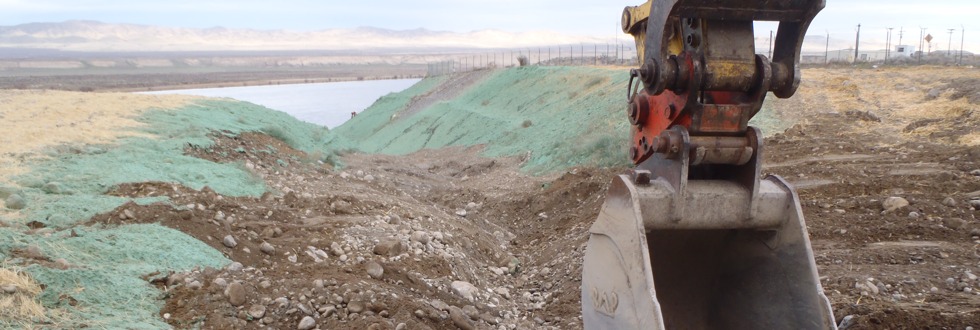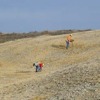Featured Projects
U.S. Army Corps of Engineers, Walla Walla District (FY 2016-2019)
Planting and Maintaining Native Riparian and Upland Shrubs and Trees
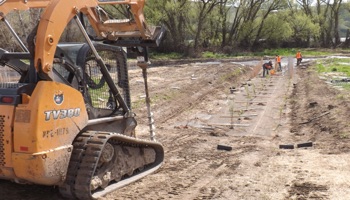
Heavy equipment contouring the earth for planting
EAS is restoring approximately 60 acres of wildlife habitat that was lost during the construction activities of the Lower Snake River Project (LSRP). The LSRP built the Ice Harbor, Lower Monumental, Little Goose, and Lower Granite Dams along the Lower Snake River for the purposes of navigation, irrigation, and hydroelectric power production. EAS’s work to restore this area to high-quality, self-sustaining, native habitat is helping the U.S. Army Corps of Engineers (USACE) meet its Lower Snake River Fish and Wildlife Compensation Plan goals and comply with the Fish and Wildlife Coordination Act. EAS worked with the USACE to understand past restoration efforts that have not yielded the desired long-term success.
EAS designed the restoration plan and has implemented a work plan to achieve the objectives. EAS will have planted 24,000 trees and shrubs by the end of the project and maintained the plantings to ensure establishment of a 65% survival rate, removing and controlling invasive plant species to facilitate planting success. All disturbed areas are re-seeded with native grass seed mix.
EAS’s restoration plan included site staging, site preparation efforts such contouring activities, planting prescriptions with specific native species compositions and site layout, native grass re-seeding, and a three-year watering and weed maintenance plan. The draft and final work plan included technical approach, work schedules, personnel training program, accident prevention plan (including use of chemicals and heavy equipment), and an environmental management plan.

Restoration of Central Ferry Habitat Management Unit
EAS has provided field crew support in a remote region of the Lower Snake River, including heavy equipment operators, sometimes during adverse weather conditions (excessive snow and ice storms) with no lost work days and the project has remained within the budget.
U.S. Department of Energy, Washington Closure Hanford
Re-vegetating, Restoring, and Mitigating National Priority List Sites

Restoring and monitoring National Priority List sites
Plutonium production operations at the 560-square-mile Hanford Site created one of the largest and most complex hazardous waste site cleanup projects in the nation. As the site is cleaned up, the Department of Energy is required to restore the land to its native vegetation. Since 2006, the EAS team has worked with prime contractors on the Hanford Site to develop mitigation plans and successfully restore native plant communities. Revegetation of semi-arid land poses a unique set of restoration challenges, including heat extremes and relatively low soil moisture throughout much of the year, which slows plant regeneration. EAS’s knowledge and experience working in the region has shown that selecting appropriate mitigation sites and preparing them appropriately is key to successful restoration.
We develop individual restoration prescriptions based on soil type and aggregate size, aspect and topography, naturally occurring adjacent vegetation, and pre-existing site conditions. To save clients time and money and foster revegetation success, we select specific site-preparation techniques and applications necessary and appropriate for each site.
EAS also conducts annual, long-term monitoring of revegetation sites to ensure the objectives of the revegetation efforts are accomplished, note planting techniques that yield the greatest success, and document successional recovery. It can take from three to five years before revegetation efforts in the region show significant signs of success. Since 2006, the EAS team has conducted more than 150 revegetation, restoration, and mitigation projects on the Hanford Site.
- 2007 River Corridor Closure Contractor Revegetation and Mitigation Monitoring Report, Washington Closure Hanford, WCH-223 Rev. 0.
- 2008 River Corridor Closure Contractor Revegetation and Mitigation Monitoring Report, Washington Closure Hanford, WCH-288 Rev. 0.
- 2009 River Corridor Closure Contractor Revegetation and Mitigation Monitoring Report, Washington Closure Hanford, WCH-362 Rev. 0.
- 2010 River Corridor Closure Contractor Revegetation and Mitigation Monitoring Report, Washington Closure Hanford, WCH-428 Rev. 0.
- 2011 River Corridor Closure Contractor Revegetation and Mitigation Monitoring Report, Washington Closure Hanford, WCH-512 , Rev. 0
These reports can be found at http://worldwidescience.org/topicpages/c/closure+contractor+revegetation.html
- 2012 River Corridor Closure Contractor Revegetation and Mitigation Monitoring Report, Washington Closure Hanford, WCH-554, Rev. 0.
This report can be found at http://pdw.hanford.gov/arpir/index.cfm/viewDoc?accession=0086145
U.S. Department of Energy, Washington Closure Hanford
Restoring a Riparian Zone and Improving Habitat along the Hanford Reach
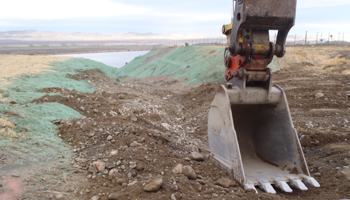
Improving habitat quality by recontouring the excavation to vary the topography
As Hanford Site buildings and other structures are demolished or removed, as part of the cleanup effort, EAS biologists are called upon to revegetate, restore and mitigate riparian and upland habitats. In 2012, for example, when the Department of Energy removed an outfall structure and pipe associated with 100-N reactor a natural-looking gulley was created in a steep featureless shoreline. Generally, excavated waste sites are backfilled to grade to restore the existing topography. At this site however, EAS saw an opportunity existed to improve the quality of habitat by recontouring the excavation to vary the topography.
As the field team’s experience showed, some plants and animals prefer to use natural or man-made areas with hills and valleys. Micro-habitats created by variations in topography benefit a variety of plants and animals. These may include temperature moderation, relief from climatic extremes (high wind and temperature), shade relief, shelter from predation, and burrowing opportunities. The EAS approach to restoring the site not only increased the diversity of habitat along the river corridor, it cost the client less than standard backfilling.
U.S. Department of Energy, Washington Closure Hanford
Identifying Bat Roosting Sites in Facilities Scheduled for Demolition
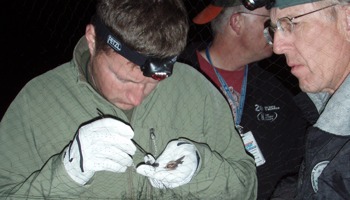
Surveying buildings for priority habitats and species, including the pallid bat
Before retired Hanford Site buildings and facilities can be demolished, federal and state guidelines require that contractors conduct surveys to identify potential biological species of concern in and around these properties. If surveyors locate state- or federal-listed species, they must evaluate impacts as a result of planned actions and recommend mitigation strategies.
Beginning in 2009, the EAS team evaluated 196 Hanford Site buildings and facilities scheduled for demolition for bat roosting sites. The state Priority Habitats and Species Program identified two bat species known to occur on the site—pallid bat and Yuma myotis—as species that “require protective measures for their perpetuation due to their population status, sensitivity to habitat alteration, and/or recreational, commercial, or tribal importance.”
The field team surveyed facilities in the 300, 400, 100-H, 100-D, 100-N, and 100-B/C areas. Surveys included inspecting facility exteriors for likely roosting habitats, bat access to the buildings, and presence of fecal pellets that would indicate bat use. We also conducted remote monitoring using an AnaBatTM SD2 acoustic bat detector set out for several nights to record bat calls. During spring investigations of the 183-D Facility, the acoustic detector recorded an extremely high level of bat activity around the headhouse portion of the building, 181 bat passes per night, compared with an average of seven at the 183-H Clearwell. The high level of activity and presence of an open door, prompted further investigations, including mist netting, infrared video recording, and acoustic monitoring with a Pettersson D240x. Field staff captured 29 Yuma myotis bats, a high rate compared with other mist netting events performed around the Hanford Site. Analysis of the acoustic data indicated most bats observed were Yuma myotis, followed by pallid bats, and a small number of canyon bats. The field determined that Yuma myotis was very likely using the headhouse for a night roost and possibly an undiscovered maternity roost.
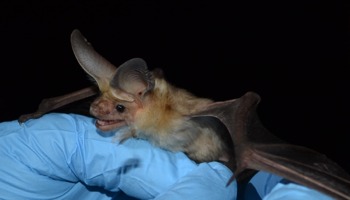
Classifying bats to assist in developing mitigation to maintain viability of colony
Later in the summer, a juvenile pallid bat was found at the 100-D Area, indicating a maternity roost was likely in the area. Further surveys of the 183-D Facility in 2010 investigated the potential for a pallid bat roost and/or a Yuma myotis roost. A 2010 video recording of the facility’s headhouse and follow-up surveys showed a maternity roost of pallid bats emerging from a small crack in the side of the cinder block. Pallid bats are a state monitor species, and their colonial roost sites are considered priority habitats. Because demolition of the 183-D Facility would significantly impact the maternity roost of pallid bats and night roosts of other bats mitigation was required to maintain the viability of this colony. Because of the importance of this site to multiple species of bats, the recommended mitigation include constructing a replacement roost near the headhouse designed to accommodate multiple species.
Washington Closure Hanford has publically released two bat roost monitoring reports describing these efforts:
- Evaluation of the 183-D Water Filtration Facility for Bat Roosts and Development of a Mitigation Strategy, 100-D Area, Hanford Site, Washington Closure Hanford, WCH-438 Rev. 0. March 2011.
- Bat Surveys of Retired Facilities Scheduled for Demolition by Washington Closure Hanford, WCH-450 Rev. 0. June 2011.
The reports can be found at http://pdw.hanford.gov/arpir/pdf.cfm?accession=0091350
